Moon Leaving Eve Gives Late Winter Treats, Northern Spring Begins, and Saturn Loses it Rings While Venus Gains One!
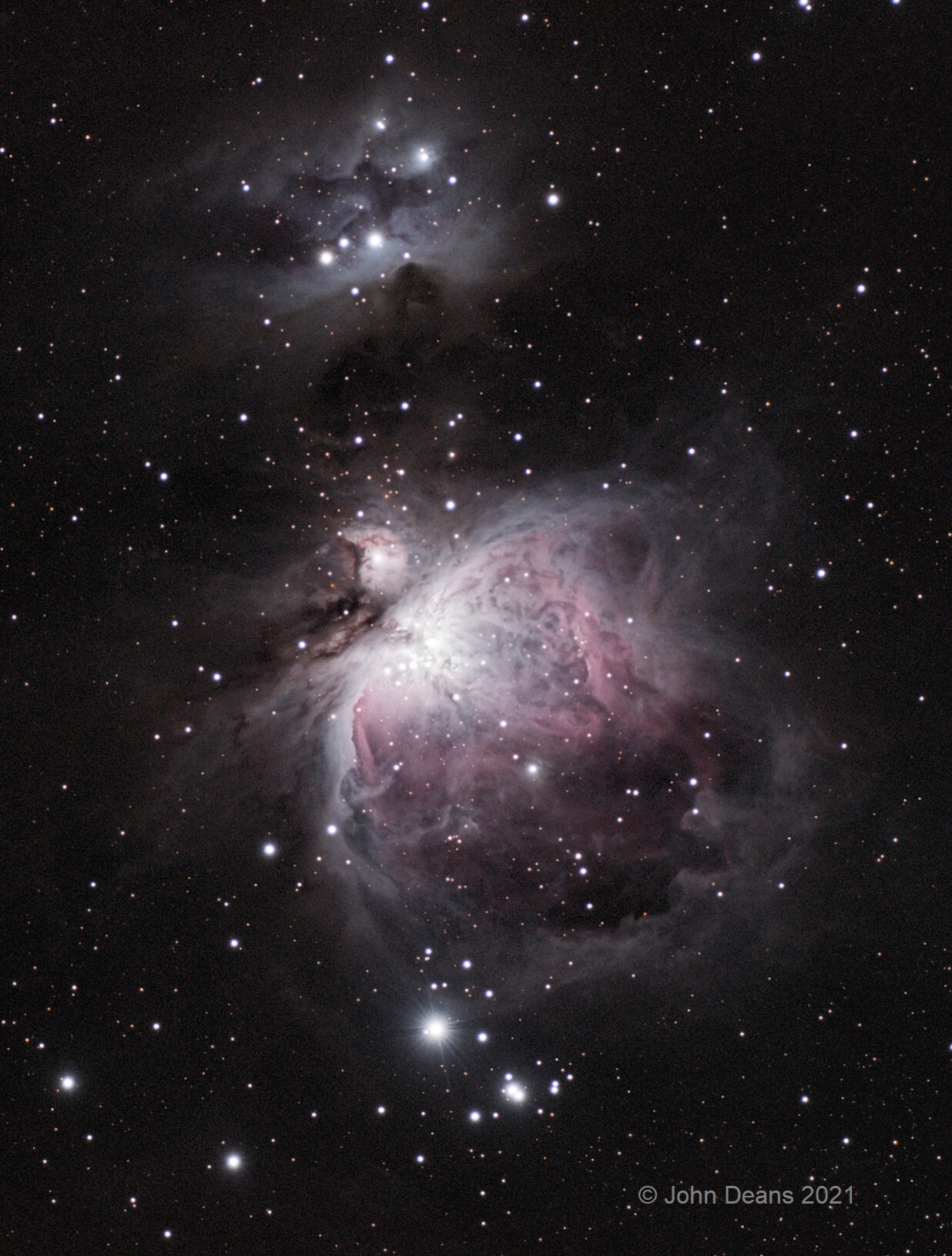
This magical image of the sword of Orion was captured and processed by my friend John Deans when he was in Bancroft, Ontario on February of 2021. All three patches of light from top to bottom are visible to unaided eyes below Orion’s three-starred belt. Binoculars and backyard telescopes will reveal the spectacular details in the big Orion Nebula at centre, including the clump of four stars of the Trapezium Cluster buried in its core.
Hello, Spring Stargazers!
Here are your Astronomy Skylights for the week of March 16th, 2025 by Chris Vaughan. Feel free to pass this along to your friends and send me your comments, questions, and suggested topics. You can also follow me on FaceBook, Instagram, Threads, and Bluesky as astrogeoguy! Unless otherwise noted, all times are expressed in Eastern Time. To subscribe to these emails please click this MailChimp link.
If you’d like me to bring my Digital Starlab portable inflatable planetarium to your school or other daytime or evening event in Simcoe, Grey, and Bruce Counties, or deliver a virtual session anywhere, contact me through AstroGeo.ca, and we’ll tour the Universe, or the Earth’s interior, together! My book with John A. Read entitled 110 Things to See With a Telescope is a guide to viewing the deep sky objects in the Messier List – for both beginners and seasoned astronomers. DM me to order a signed copy!
The sun’s trip along the ecliptic will deliver spring in the Northern Hemisphere on Thursday. Following the full moon’s eclipse, our natural satellite will wane and rise later, leaving the evening sky worldwide nice and dark for viewing the deep sky delights of late winter. Mercury and Venus will depart from the western sky after sunset, the latter showing a crescent that may stretch to encircle the cloudy planet. Jupiter and Mars will shine in evening, and Saturn, near the pre-dawn sun, will lose its rings for a while! Read on for your Skylights!
Northern Spring Begins!
On Thursday at 4:01 am EDT or 1:01 am PDT (and 09:01 Greenwich Mean Time in other parts of the world), astronomical spring will officially arrive for the Northern Hemisphere! At that moment, the sun’s apparent eastward motion along the ecliptic will carry it cross the celestial equator and into the northern sky. (Of course, the sun isn’t moving – the Earth is!) The astronomical term for this event is the Vernal Equinox, where the word “vernal” is Latin for “spring”. I prefer to say March Equinox because that same day will launch autumn for everyone in the Southern Hemisphere. The hemispheres will trade autumn for spring again at the September or Autumnal Equinox.
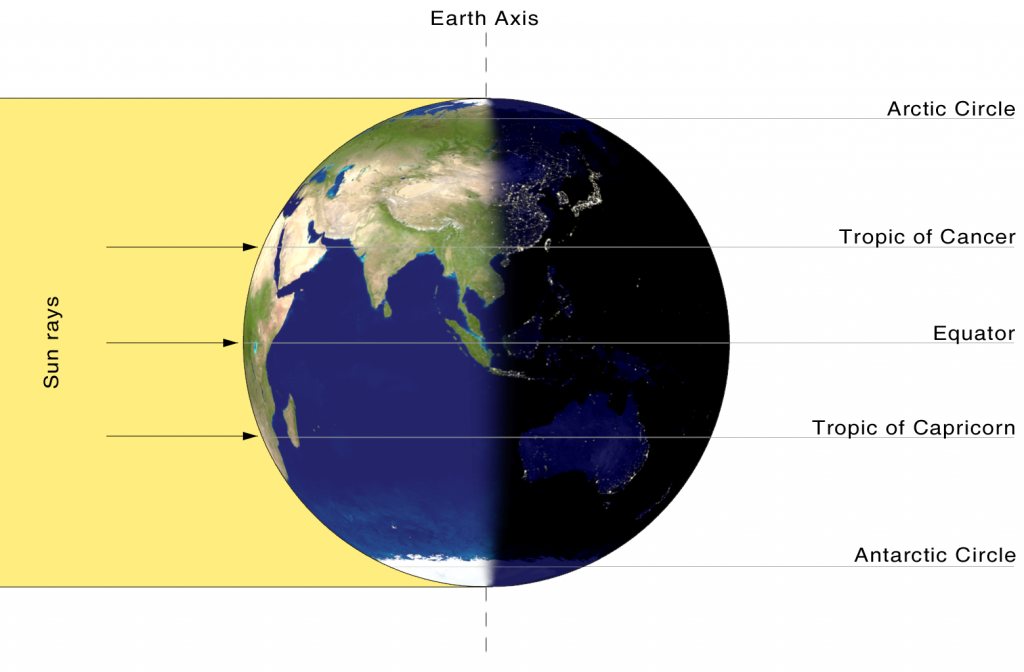
The dates that the equinoxes and solstices land on vary a bit due to the non-integer number of days in the solar year. If we didn’t use leap years to correct for the extra 0.24 days contained in each 365.24-day year, the seasons would wander around the calendar! The meteorological definition of spring is March 1 to May 31, corresponding to when the mean temperatures and daylight hours are increasing fastest. Since Earth’s orbit is elliptical, it speeds up and slows down during the year, making winter in the Northern Hemisphere quite a bit shorter than summer. The meteorological definition keeps each season about 92 days long.
On each of the two equinox dates every year, the world experiences about 12 hours each of daylight and 12 hours of darkness. This is where the word equinox (Latin for “equal night”) comes from. The actual date containing 12 hours of day and night, known as the equilux, varies according to latitude. In the zone encompassing southern Canada and the northern USA states, that occurs on Monday, March 17 in 2025. The day-night balance varies by latitude and doesn’t quite hold true at the poles where you could climb a ladder and see the sun.

The amount of daylight is always padded by a few minutes because it takes 2 minutes for the disk of the sun to fully rise or set at the equator. That interval lengthens as you travel farther north or south of the equator because the tilt of the ecliptic increases, making the sun rise on a slant. In other words we’ve already started to see the sun when its centre crosses the horizon rising, and we still see the upper half of the sun for a while after its centre sets. On top of all that, Earth’s atmosphere bends (or refracts) light, allowing us to “see” the sun even when it is actually below the horizon. The amount varies by atmospheric pressure, but that atmospheric refraction gives us another 2 minutes or so of visible sun at both ends of each day.
The March Equinox produces several interesting effects. For the following six months, the sun will spend more than 50% of each 24-hour period shining overhead of the lucky folks in North America, Europe, and Asia! More time with the sun above the horizon means warmer air and longer daylight hours! At the same time, folks in the Southern hemisphere have to accept shorter, colder days and longer nights. (Warmly dressed astronomers don’t mind long winter nights!)

The amount of daylight added each day increases fastest around the equinox. With the sun setting about 1.2 minutes later every night and rising about 1.8 minutes earlier every morning, each subsequent day brings three more minutes of daylight. Conversely, the amount of daylight decreases by about three minutes per day around September 20. The day/night balance changes crawls to a stop at the winter and summer solstices in later December and June, respectively.
The period around the equinoxes also offer increased odds of seeing the aurorae at both high northern and southern latitudes. Just as two bar magnets lined up with their poles in the same direction repel one another strongly, the Earth’s magnetic field repels the sun’s field. At the equinoxes, the Earth’s axial tilt is orthogonal to the Earth-sun line, so the two “magnets” aren’t as parallel, reducing Earth’s ability to repel the sun’s field and the charged particles that trigger aurorae in our upper atmosphere.
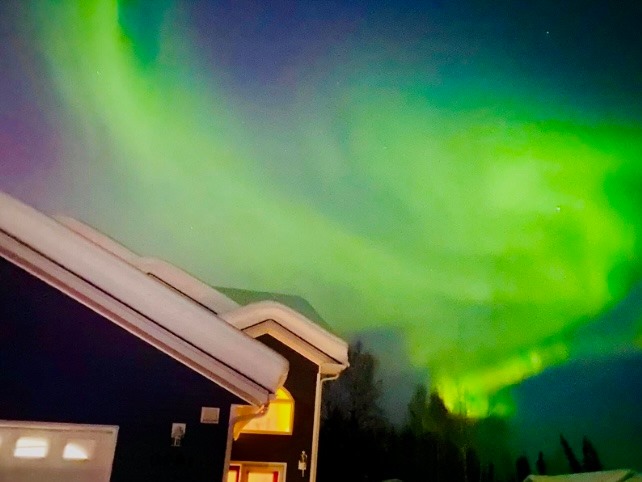
It seems highly likely that St. Patrick’s Day, now observed annually on March 17, arose after the early Christian Catholic church converted pre-existing Celtic celebrations that were already being observed at the equinox into a church feast day. It drifted away from the typical equinox date because of inaccuracies in the Julian calendar.
Persians will celebrate their New Year, called Nowruz or Norooz “New Day” on Thursday, March 20, 2025. It begins at the midnight hour occurring closest to the March equinox, as measured in Iran Standard time. In 2025, spring in Iran begins on March 20 at 11:31 am IRST. The Persian calendar, which originated with the Babylonians, is based on the sun, but not the moon. I discussed this and other connections between world religions and astronomy during an Insider’s Guide to the Galaxy session on YouTube here.
The Moon
The moon will gradually exit the evening sky worldwide this week and become a feature of the predawn and early morning sky. That will deliver dark, spring evening skies for enjoying the stars and the many faint galaxies that are visible at this time of year.
Tonight (Sunday) the bright, but waning gibbous moon will rise below Spica, the brightest star in Virgo (the Maiden) around 10 pm local time. They’ll cross the sky together and appear low in the southwest on Monday, when Spica will be sparkling to the moon’s right (or celestial northwest). The brightening sky will hide the star, but leave the moon visible.
The moon’s continuous eastward orbital motion around Earth will cause it to wane in illuminated phase, rise about an hour later each night, and linger that much longer into the morning daylight. It will travel through Libra (the Scales) on Tuesday and Wednesday morning. Early risers on Thursday can see the half-moon posing to the lower left of the up-down line of little stars that form the claws of Scorpius (the Scorpion). The bright, reddish star Antares, which marks the beast’s heart, will be located to the moon’s left, and will remain visible for a time after the dawn steals the claw stars. The moon and Antares will be cozy enough to share the view in binoculars. Observers located in most of Australia, southern New Zealand, and westernmost Antarctica can watch the moon cross in front of (or occult) Antares with their unaided eyes and through binoculars, and telescopes. Use an astronomy app to look up the exact time of the occultation where you live.

The moon will spend the coming weekend passing through the Teapot-shaped stars of Sagittarius (the Archer) and then crossing the blue, daytime sky until almost noon as the pale ghost of night. It will reach its third quarter phase on Saturday at 6:29 am EDT, 3:29 am PDT or 11:29 GMT. At third, or last, quarter the moon always appears 50%-illuminated, lit on its western hemisphere, the side towards the pre-dawn Sun. The 7-10 nights of dark, moonless evenings that follow this phase are ideal for observing deep sky targets in binoculars and telescopes, especially springtime galaxies.
Evening Zodiacal Light
If you live in a location where the sky is free of light pollution, you might be able to spot the Zodiacal Light from now until the new moon on March 29. Starting tonight (Sunday), after the evening twilight has faded, you’ll have about half an hour to check the western sky for a broad wedge of faint light extending upwards from the horizon and centered on the ecliptic below the planet Jupiter. That glow is the zodiacal light – sunlight scattered from countless small particles of material that populate the plane of our solar system. Don’t confuse it with the brighter Milky Way, which extends upwards from the northwestern horizon in evening at this time of year.

Earth Crosses Saturn’s Ring Plane
On Sunday, March 23, the dance of Saturn and Earth in their orbits will carry us from the north side to the south side of the plane defined by Saturn’s rings, an event that happens every fourteen to seventeen Earth years. On that date, the planet’s very thin rings will effectively vanish from view for a number of hours, leaving the planet as a simple, unadorned globe, like Jupiter.

During the weeks surrounding the crossing, the rings appear through backyard telescopes as a thin line drawn through Saturn. Unfortunately, this crossing will occur while Saturn is only 10 degrees from the pre-dawn sun and positioned just above the horizon for observers at mid-northern latitudes. Folks viewing Saturn from mid-southern latitudes will have the best chance to see the planet without its iconic rings, but the view will still be hampered by morning twilight and atmospheric turbulence and haze over the eastern horizon. The next ring plane crossing will be in October, 2038, when Saturn will be easy to see while it’s a substantial 28 degrees from the morning sun. Mark your calendars!
The Planets
The inner planets Mercury and Venus will continue to shine near one another in the western sky after sunset this week. Both planets sunward motions in their orbits, and their resultant lower positions night over night, will make them harder and harder to spot just above the horizon as the sky is darkening. Once you find bright Venus, search about one binoculars’ field to its upper left for much fainter Mercury. Strong binoculars or any backyard telescope will show that Venus has large and very slim, 1.5%-illuminated crescent phase, while Mercury will have a thicker crescent that is about six times smaller than Venus. Try on the first clear evening this week, and be sure to wait until the sun has completely disappeared from sight before using any optical aids above the western horizon.

When Venus is very near to the sun in the sky and crossing between us and the sun, its thick atmosphere can refract the sunlight shining on the side of the planet facing away from Earth and produce almost a complete ring of light around Venus’ disk. If you are able to aim a telescope at Venus while avoiding the nearby sun, you can see the effect while Venus is shining high in a daytime sky. I have done this with a computerized GoTo telescope by leaving all the lens caps on until Venus is centred and also using a shield to prevent any sunlight from entering the telescope. Before looking through any telescope aimed near the sun, place your hand over the eyepiece to ensure that no bright light is coming out of it. Please be extremely careful.

Around the time that Mercury and Venus are setting, the sky will be dark enough to glimpse very bright Jupiter shining high in the southwestern sky. Once reddish Mars pops out of the twilight after 8 pm, the two planets will be on either side of a huge oval composed of the bright stars Capella, Procyon, Sirius, Rigel, and Aldebaran. The red giant star Betelgeuse will shine within the oval on Jupiter’s lower left. Use your fist held at arm’s length and one eye closed to measure the span from Sirius at the lower left up to yellowish Capella above Jupiter. You should count 6.5 fist diameters or 65° of the sky. The Jupiter to Mars distance will be 3.5 fist diameters. A few minutes more will bring out Orion’s three belt stars between Betelgeuse and Rigel, and Gemini’s twin stars Pollux and Castor near Mars.

Just a friendly head’s up that we only have about six weeks remaining in which to see clear views of Jupiter in a telescope. After that it will drop lower in the post-sunset sky and appear hazy. The number of hours we can see it each evening nowadays is also diminishing as the later sunsets delay the onset of darkness. After we lose sight of Jupiter altogether in late May, you’ll have to wake up before dawn to see any planets. Other than a short, so-so visit by Mercury in mid-June, we won’t have any planets to view in the evening until Saturn returns in late July.
For now, when viewed in any size of telescope, Jupiter will display a large disk striped with dark brown belts and beige light zones, both aligned parallel to its equator. With a better grade of optics, Jupiter’s Great Red Spot, a cyclonic storm that has raged for hundreds of years, becomes visible for several hours when it crosses the planet every 2nd or 3rd night. For observers in the Americas, that GRS will cross Jupiter’s disk during early evening on Sunday, Tuesday, Thursday, and next Sunday, and also around midnight Eastern time on Monday, Thursday, and Saturday night. If you have any coloured filters or nebula filters for your telescope, try enhancing the spot with them.
Any size of binoculars will show you Jupiter’s four Galilean moons named Io, Europa, Ganymede, and Callisto lined up beside the planet. Those moons complete orbits of the planet every 1.7, 3.6, 7.2, and 16.7 days, respectively. If you see fewer than four moons, then one or more of them is crossing in front of or behind Jupiter, or hiding in Jupiter’s dark shadow – or two of the moons are very close together, or one moon is eclipsing or occulting another one.
From time to time, observers with good quality telescopes can watch the black shadows of the Galilean moons travel across Jupiter’s disk. In the Americas, Io’s small shadow will cross Jupiter on Wednesday evening, March 19 between 9:24 pm and 11:33 pm EDT (or 01:24 to 03:33 GMT on Thursday). Additional shadow crossings will be visible in other time zones.

This month, the distant ice giant planet Uranus will be located two fist diameters to the lower right of Jupiter and a palm’s width below the Pleiades Star Cluster. With the moon out of the sky, Uranus will be observable from the end of evening twilight until about 10:30 pm, when it will be hitting the treetops in the west. Uranus can be seen with unaided eyes if you know where to look. If you use your binoculars to find the up-down pair of medium-bright stars named Botein and Al Butain IV (aka Epsilon Arietis), Uranus will be the dull-looking blue-green “star” located several finger widths to their left (or southeast). In a backyard telescope, Uranus will appear as a fairly prominent, non-twinkling blue-green dot.
As I mentioned above, Mars’ medium-bright, reddish dot will shine high in the southern sky after dusk, where it will form a triangle to the lower right (or celestial southwest) of Gemini’s bright stars Pollux and Castor. Mars will be highest due south around 9 pm local time and then set in the west by 5 am local time. Our 149 million km distance from Mars is increasing every night, so the planet is shrinking in size and losing its brilliance. Your good quality backyard telescope might still show its bright polar cap, some dark patches on its small reddish globe, and the fact that it now has a gibbous, 91%-illuminated disk. We’ll continue to see Mars as a bright dot until late July, but do your close-up viewing sooner than later.
Stargazing Sights for Mid-March
With the moon missing from the evening sky until later this week, and the milder, bug-free conditions, it’s a fine time to explore the wonders of the dark sky in binoculars and backyard telescopes. Next week, I’ll talk more about the many galaxies we can enjoy on moonless spring nights.
The constellation of Auriga (the Charioteer) is high in the western sky during March evenings. Below its very bright, yellow-tinted star Capella, nick-named the Goat Star, look for a narrow triangle of smaller stars known as “the Kids”. From the Kids you can continue sweeping clockwise to the left (or celestial south) of Capella to trace out a rough oval of stars measuring 1 by 1.7 fist diameters. The outer rim of our Milky Way passes through Auriga, filling the lower left (or southern) half of the oval with star clusters and nebulas. Several of them are very obvious if you scan the constellation with binoculars from a dark location.

Search midway between Auriga’s lowest star Hassaleh (Iota Aurigae) and Mahasim (Theta Aurigae) above it for a large triangle of bright open star clusters. One named Messier 38 located halfway between those bright stars shows a large, loose scattering of stars, hence its nickname the Starfish Cluster. Another nice cluster named NGC 1893 three finger widths to its lower left has the nickname the Letter Y Cluster because of the pattern its stars form. The Pinwheel Cluster or Messier 36, which positioned a thumb’s width inside the ring midway between the Mahasim and the star Elnath, is nicely concentrated, with stars arranged in curved arcs. The Salt and Pepper Cluster or Messier 37, which will sit opposite to the Pinwheel, but on the outside of Auriga’s ring, is composed of a very dense collection of stars. Aim a backyard telescope two finger widths to the right of the Kids to find the Kite Cluster or NGC 1664. It’s not very bright, but it’s very pretty! At the same distance from the Kids, but inside Auriga’s ring you’ll find a large, loose cluster named NGC 1778.
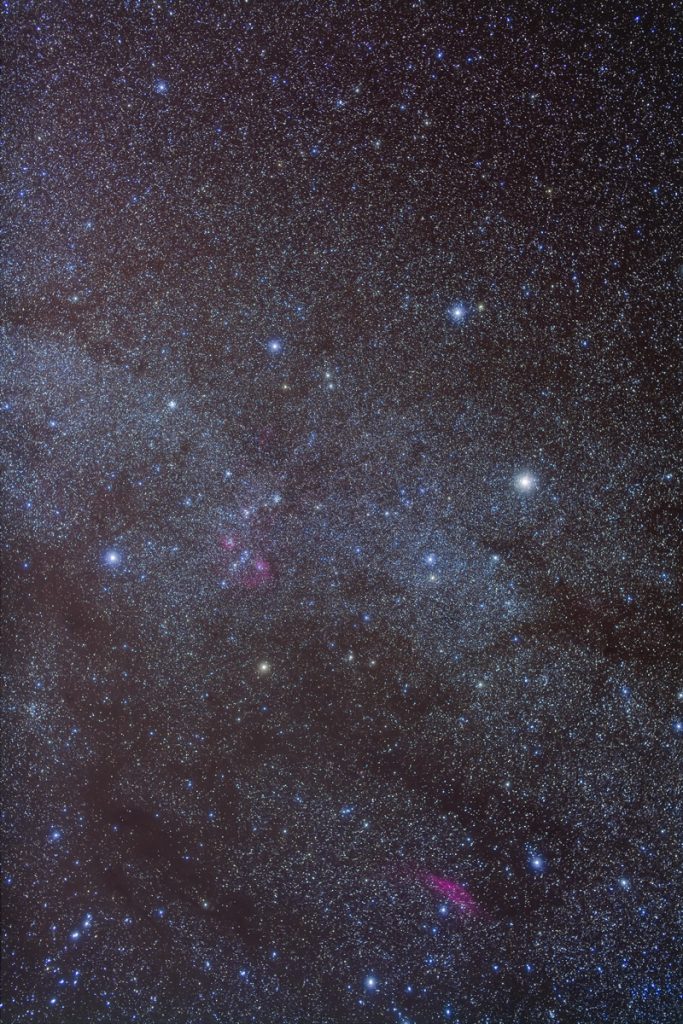
The faint stars of the large constellation of Monoceros (the Unicorn) occupies the sky to the left (or celestial east) of Orion (the Hunter). The very bright stars Procyon and Sirius gleam above and below the unicorn, respectively. Often overlooked, this constellation straddles the winter Milky Way. Among its many treasures are the spectacular Rosette Nebula (or NGC 2237) and its internal star cluster NGC 2244. The Rosette Nebula is more than double the size of the moon, so it shows very well in binoculars. Search a slim palm’s width above the Rosette Nebula for the Christmas Tree Cluster. The area around and below that cluster hosts a large triangle of faint nebulosity named NGC 2264, adding to the Christmas tree appearance. It’s upside-down in binoculars and right-way-up in a telescope. The Double Wedge Cluster (or NGC 2232) and the spectacular triple star Beta Monocerotis sit a fist’s diameter to the upper right (or 10° to the celestial north) of much brighter Sirius.

The Sword of Orion hangs below the three-starred belt of Orion (the Hunter). That bright constellation is easy to find about halfway up the southwestern sky after dusk at this time of year. On the sky the sword measures a finger’s width wide by a thumb’s width high (or 1.5 by 1 degrees). The patch of light in the middle of the sword is the spectacular and bright nebula known as Messier 42, M42, and the Orion Nebula. Even binoculars will reveal the fuzzy nature of this object. De Mairan’s Nebula or Messier 43, which sits just above the Orion Nebula, is a section of the same interstellar gas cloud that has been separated from it by a lane of dark dust in the foreground. A medium-to-large backyard telescopes will reveal a complex pattern of veil-like gas and dark dust that form M42 and M43. The nebula, and the stars forming within it, are approximately 1,350 light-years from our sun and fill a volume of space measuring 24 light-years across.
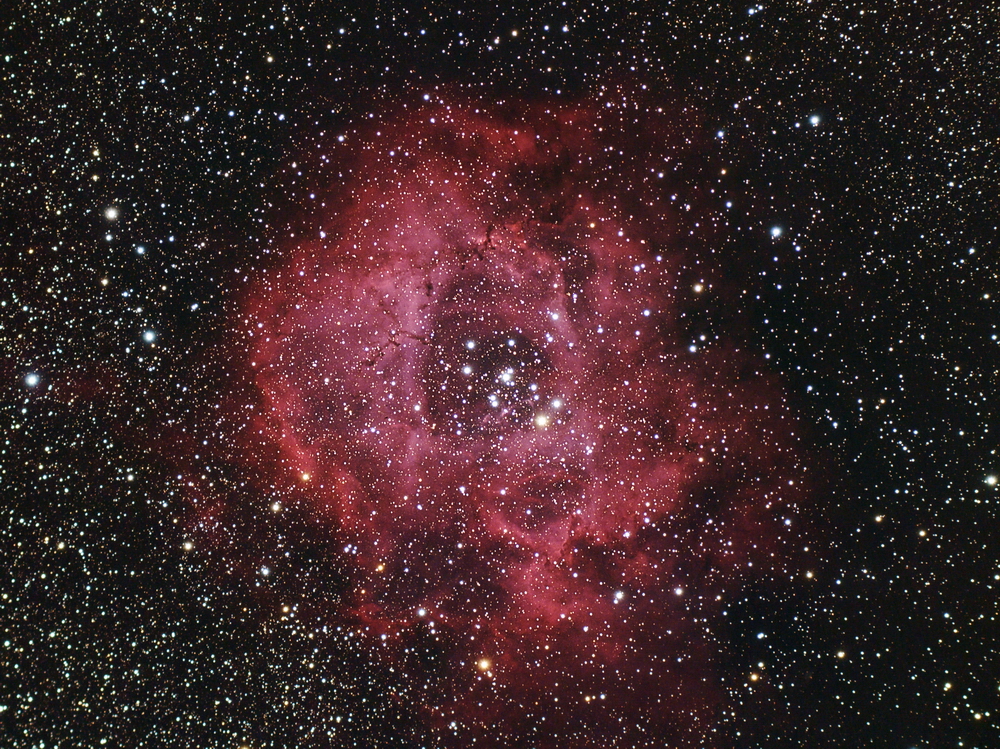
Buried in the core of the Orion Nebula is a tight cluster of stars collectively designated Theta Orionis (Orionis is Latin for “of Orion”), but is better known as the Trapezium – because the brightest four stars occupy the corners of a trapezoid shape. Even a small telescope should be able to pick out this four-star asterism – but good seeing conditions and a larger aperture telescope will reveal two additional faint stars in the trapezoid. The Trapezium stars are hot, young O- and B-type stars that are emitting intense amounts of ultraviolet radiation. The radiation causes the Hydrogen gas they are embedded within to shine brightly as red light. At the same time, some of their light is scattered by surrounding dust, producing blue light. The combination of red and blue is why there is so much purple and pink in colour images of the nebula. The Trapezium stars will be easy to see from light polluted areas where the surrounding nebula might not be. Their shape can even be glimpsed in binoculars!
Scan half a finger’s width (or 30 arc-minutes – equal to the full moon’s diameter) above the Orion Nebula to find another clump of stars dominated by the stars c Orionis and 45 Orionis. A larger telescope, or a long-exposure photograph, will reveal a bluish patch of nebulosity around them that contains darker lanes forming the shape of a figure, called the Running Man Nebula (or NGC 1977). This is another case of dust and gas scattering blue light from those two stars. Just above the Running Man sits a loose cluster of a few dozen stars called the Coal Car Cluster (or NGC 1981). It is best seen in binoculars or low telescope magnification.

To the unaided eye, a patch of brightness just below the Orion Nebula defines the southern tip of Orion’s sword. That area is dominated by the bright, magnitude 2.75 star named Nair al Saif “the Bright One of the Sword”. It also goes by Hatysa, Iota Orionis, and the nick-name “The Lost Jewel of Orion”. The star is expected to explode in a supernova one day. It, too is surrounded by faint nebulosity. Astronomers believe that this star was gravitationally kicked out of the Hyades Cluster in Taurus (the Bull) about 2.5 million years ago.
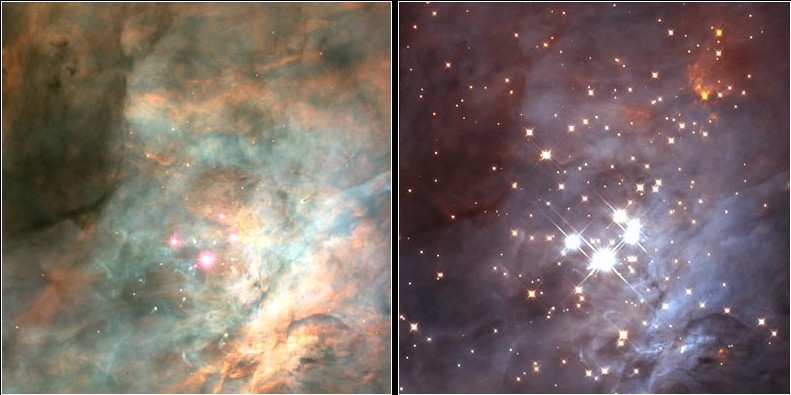
Just a short distance below (or 8 arc-minutes to the celestial southwest of) Nair al Saif, you’ll find a pair of medium-bright, magnitude 4 stars designated HIP 26199 and HIP 26197. This duo is almost 3,000 light-years from the sun and they shine with an intense blue light indicative of their extremely high temperatures. Astronomers estimate that each of those two stars is approximately 40,000 times more luminous than our sun.
Public Astronomy-Themed Events
Every Monday evening, York University’s Allan I. Carswell Observatory runs an online star party – broadcasting views from four telescopes/cameras, answering viewer questions, and taking requests! Details are here. They host in-person viewing on the first clear Wednesday night each month. Other Wednesdays they stream views online via the observatory YouTube channel. Details are here.
At 7:30 pm on Wednesday, March 19, the RASC Toronto Centre will livestream their free monthly Speaker’s Night Meeting. The speaker will be Alex Jude, a BSc candidate and science educator at York University. The topic will be An Educational Guide to AICO’s QUAIL Telescope. Check here for details and watch the presentation at https://www.youtube.com/rasctoronto/live.
On Saturday, March 22 from 8:30 to 10:30 pm EDT, the in-person Astronomy Speakers Night program at the David Dunlap Observatory in Richmond Hill, Ontario will feature Dr John Moores of York University. His talk will be Daydreaming in the Solar System: Exploring the Planets with our Five Senses.After the presentation, participants will view interesting celestial objects through telescopes on the lawn (weather permitting). More information and the registration link is at ActiveRH.
Keep your eye on the skies! I love getting questions and requests. Send me some!